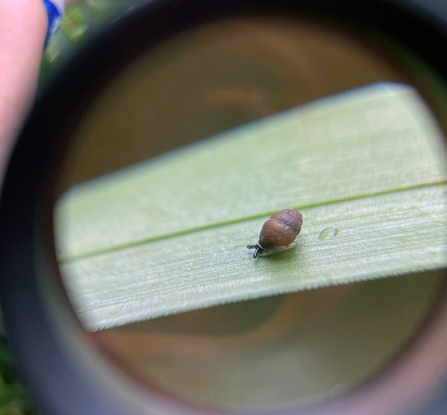Desmoulin’s whorl snail (Vertigo moulinsiana) is a tiny, air-breathing wetland snail, one of the UK's Biodiversity Action Plan Species. It is the largest in its genus, with a maximum shell height of 2.6 mm, and is distinguished from its close relatives by four tiny "teeth" inside the lip of its shell. Because of its minute size and scarcity, finding it in its preferred habitat of reedbeds is a definite challenge.
Desmoulin’s Whorl Snail Discovery

Desmoulin's Snail in the bow hole of a key for scale
It is only found in calcareous habitats, so the rivers and associated wetlands of the Avon, Wylye, and Bourne form a key network of lake margins, fens, and riverbanks that are nationally and internationally significant, with this snail being extremely rare across its entire range in Europe. Not much is known about its life cycle and habitat preferences, but it eats the thin layer of algae and bacteria found on plants, and it needs high humidity - travelling up the blades of reed sweet-grass and tussock sedge in August to breed and retreating into the leaf litter in winter.
Despite being reasonably widespread through the River Avon and its catchment, this snail exists in highly variable populations that can boom or bust from year to year. Its tiny nature means that it can't really go against the current, meaning we try and protect its source populations at reserves like Jones's Mill.
A new record at Smallbrook
During surveys this summer, we discovered the snail at Smallbrook Meadows - a first for our records. It was found in an area where we previously re-wiggled a stretch of the River Were, a tributary of the Wylye, into a more natural path from its former, artificial straight route. This area has been largely untouched for two years now and has developed a varied assemblage of plants, from dense stands of willowherb on open stony banks to impenetrable bullrush around hidden pond margins.

To find the snail here for the first time is an indication that changing the morphology of rivers back into a more naturalistic state can help scarce animals and plants find their niche and thrive in areas that abstraction and agricultural intensification once made uninhabitable. We hope that further surveys along these rivers will rediscover lost populations, find new habitats, and allow us to target interventions to help this elusive snail and the surrounding wildlife thrive in this county.

